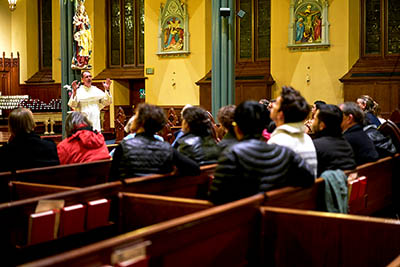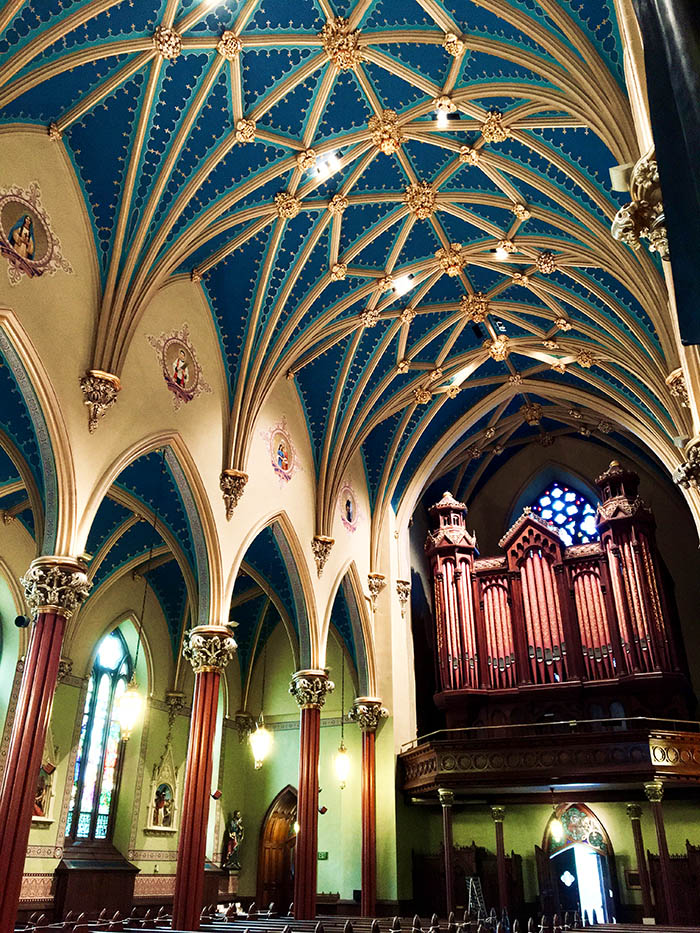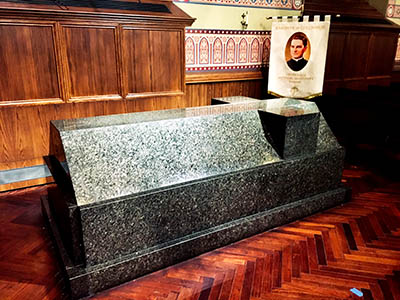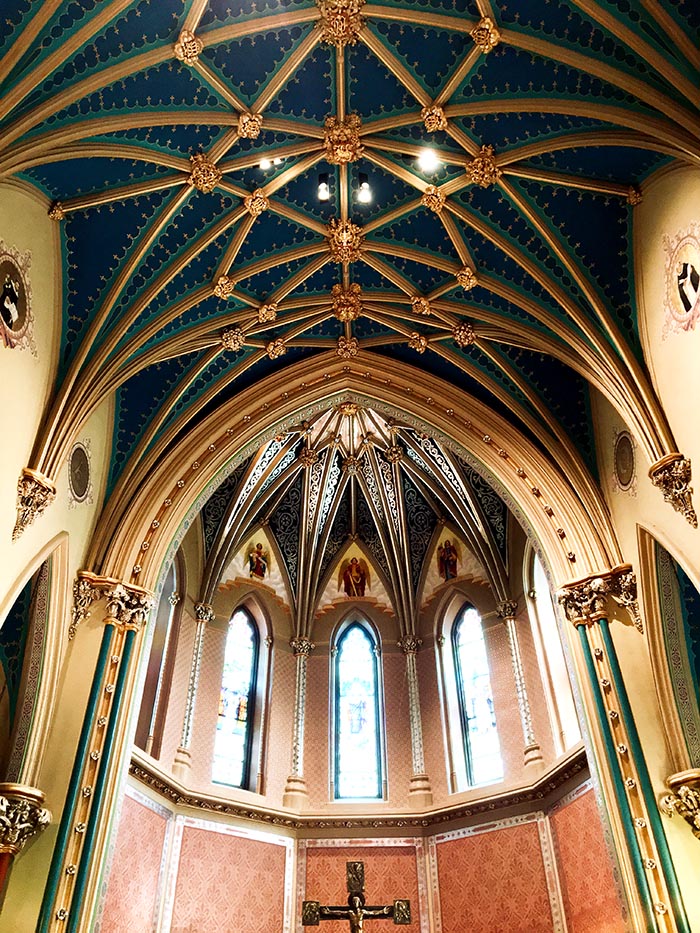by Vanessa Avery Executive Director, Sharing Sacred Spaces, Inc.
On the evening of November 13, 2018, a group of about 60 interfaith program participants gathered together at an 1874-vintage church of the Roman Catholic Dominican Order, St. Mary’s, located in the heart of New Haven, Connecticut. The purpose of the event was to bring together eight different religious congregations across Greater New Haven to explore Roman Catholic architecture under the gracious hospitality of St. Mary’s clergy and congregants.
As everyone arrived, the vestibule came alive with hugs and smiles as people greeted one another. When the doors opened, the element of surprise was tangible. Eyes were drawn upward to the deep blue vaulted ceiling. St. Mary’s nave (from the Latin navis, meaning ship) was, indeed, a microcosm of the Catholic worldview. We eventually took our seats in the pews, our metaphorical ship, sailing under the blue sky towards the apse where the crucified Christ revealed salvation and a promised future.
Modeled after ancient Roman basilicas, the aisles of the nave led straight to the apse. But here, in this sacred space, rather than focusing on an image of a Roman emperor, we saw Christ the King. The shape of the space was designed partly as a critique of its pagan ancestors but more importantly was a powerful and physical orientation to the Catholic worldview. The entire evening was to be marked by such beauty, and its ability to bridge reason and revelation
The Church has long been understood as a body not of stone and mortar, but of believers. And yet the spaces believers inhabit for worship, supplications, and acts of communal identity are of significant symbolic, social, historical, and extra-church import. The physical spaces of churches hold memories of a particular geographic community, and even express local theologies, concerns, hopes, and prayers.
The restoration of a particular church—in this case St. Mary’s—was a community-building act in and of itself, providing a window into its neighborhood. And sharing the space of this church on that November evening with local groups from other faith traditions was an essential part of that community-building act.

Father John Paul Walker of St. Mary’s Church leads a discussion of the building’s history during a Sharing Sacred Spaces gathering.
Photo: Courtesy of Sharing Sacred Spaces, Inc.
Restoring St Mary’s
Fewer than two weeks after the gathering, near-tragedy struck: old plaster from that ceiling collapsed to the nave floor (luckily no one was injured). Soon after, inspectors assessed the entire sanctuary and several architectural elements were found to be unstable. A massive restoration project lay ahead.
St. Mary’s is one of the oldest and most venerated Catholic churches in the country. Indeed, its history closely parallels that of America itself. Founded in the late-1800s in a mainly Protestant, originally Puritan New England town, St. Mary’s was a bastion of strength for a Catholic faith that appealed across classes, including the working classes of New Haven recently immigrated from Europe. The parish was established in 1827 and dedicated its building in 1874. Within a decade, its pastor, Father Michael McGivney, founded the Knights of Columbus (the world’s largest Catholic fraternal service organization) in the basement of St. Mary’s “to help strengthen religious faith and to provide for the financial needs of families overwhelmed by the illness or death of the breadwinner.” It is not an exaggeration to say that the role of St. Mary’s in the evolution of America and the American experiment is large and important.
In its response to the sudden need for a nearly complete restoration of the church, the congregation of St. Mary’s in many ways relived the spirit of its early days. The congregants came together and turned their weekly gatherings into restoration discussions. Consensus formed around renovating the church in a style that was both faithful to the original and representative of today’s community of faith. They found old newspaper clippings from the late 1800s that mentioned, for example, original colors that were softer than those of later years, and also that there had been images of saints depicted on the upper walls running alongside the nave ceiling. Both of these findings informed the restorations, and in light of the latter, Father John Paul Walker turned the church’s online weekly meetings into open forums to discuss and choose 14 saints whose images would line the walls. The community first chose the most famous four Dominicans (St. Dominic, St. Thomas Aquinas, St. Catherine of Sienna, and St. Rose of Lima). Second, were saints chosen for their close association with the Virgin Mary (for whom the church is named) or persons who saw apparitions of her. Third, they focused on intercultural and international connections, choosing one South American, a Native American, and two Mexican saints. Notably they also decided to include St. Maximillian Kolbe, a Polish Franciscan who was executed and martyred at Auschwitz, and Pope John Paul II, both of whom made huge strides in the Church’s relationship with Judaism and the Jewish people.
Through an exercise in internal community-building and research into the history of the site, the church’s restoration itself became a symbol, a mirror, and a celebration of the vision, values, and concerns of the community it now serves.

Restored nave in St. Mary’s is crowned with portraits of Roman Catholic saints significant to St. Mary or the Dominican Order.
Photo: Michael J. Crosbie, FAIA
Sharing Sacred Spaces
While the commitment to intercultural and interreligious understanding has been emphasized in recent years, that commitment is not new. In 2018, St. Mary’s joined a community-building program run by Sharing Sacred Spaces, a nonprofit based in Chicago. The Interreligious Communities Project has brought together congregations from eight different denominations or faith traditions in New Haven to work together, build skills in dialogue, and create deeper understanding through embodied “spatial” experiences inside each other’s sacred spaces (similar Sharing Sacred Spaces programs are active in Stamford, Connecticut, and Toronto, Ontario). The program’s ultimate focus is to build trust across difference, generate goodwill, and foster a greater sense of community via shared spatial experience.
St. Mary’s experience demonstrates that a church is not simply a body of believers, nor is it just stone and mortar. Sacred spaces demonstrate the history, interests, hopes, concerns, and values of the people who use them. Moreover, each space also conveys theology and tradition—embodying the belief system of the faith tradition. Spaces can define boundaries and elicit questions, reflection, and insight. Sharing Sacred Spaces believes that we can all deepen our own faith by becoming embodied within the “faith-space” of another tradition.
Touring St. Mary’s as the originating space of the Knights of Columbus, for example, and witnessing the tomb of the Knights’ founder Father McGivney, builds instant geographic connections for any New Haven resident who might regularly pass the four-tower Knights of Columbus headquarters that stands at the entry to New Haven’s downtown. The origin story of the establishment of St. Mary’s, similarly, conjures up parallel histories of discrimination that have been experienced by those from Jewish and Muslims traditions; indeed, the troubles and tribulations of the early Catholics of New Haven highlight experiences that have parallels in many cultures and religions.
As the members of eight traditions and denominations around New Haven shared the space of St. Mary’s on that November night, people found their common humanity. Sacred architecture showed its power to be deeply humanizing and transformational—starting with the crossing of boundaries, exploration of differences, and the discovery of interconnectedness.

The tomb in the side aisle of St. Mary’s of Father Michael McGivney, who founded the Knights of Columbus, is the site of pilgrimage visits from around the world.
Photo: Michael J. Crosbie, FAIA
Conclusion
Anglican theologian Sarah Coakley once remarked “The Church is not a building,” but is rather a body of believers. But the physical space of St. Mary’s and other sacred places are essential and compelling doorways through which interreligious understanding, spiritual reflection, deepening faith, and transformational friendships across difference can transpire. By sharing its sacred space, and the facilitated “spatial” experience, the Catholic communal story transcends boundaries and provides inter-human connectedness.
AUTHOR NOTE
Vanessa Avery is the Executive Director of Sharing Sacred Spaces, Inc., which builds local, diverse, model micro-communities through sustained partnership and action using the unique vehicles of sacred space, architecture, and radical hospitality. A Lecturer in Interfaith Engagement at Yale Divinity School and affiliate faculty at California State University, Avery is the author of numerous articles on world religions, interfaith understanding, organizational culture, and religion, violence, and peace.

